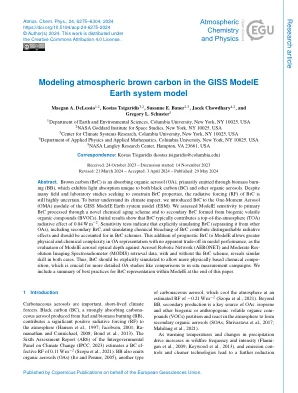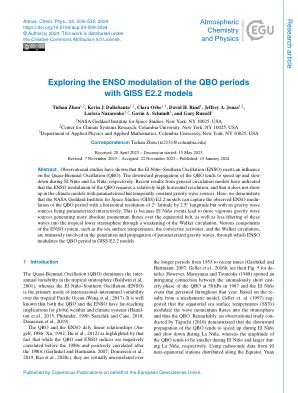XiaoMi-AI文件搜索系统
World File Search System在GISS Modele地球系统模型中对大气棕色碳进行建模
摘要。Brown carbon (BrC) is an absorbing organic aerosol (OA), primarily emitted through biomass burn- ing (BB), which exhibits light absorption unique to both black carbon (BC) and other organic aerosols.Despite many field and laboratory studies seeking to constrain BrC properties, the radiative forcing (RF) of BrC is still highly uncertain.To better understand its climate impact, we introduced BrC to the One-Moment Aerosol (OMA) module of the GISS ModelE Earth system model (ESM).We assessed ModelE sensitivity to primary BrC processed through a novel chemical aging scheme and to secondary BrC formed from biogenic volatile organic compounds (BVOCs).初始结果表明,BRC通常贡献0.04 Wm-2的辐射效应最高的辐射效应。Sensitivity tests indicate that explicitly simulating BrC (separating it from other OAs), including secondary BrC, and simulating chemical bleaching of BrC contribute distinguishable radiative effects and should be accounted for in BrC schemes.This addition of prognostic BrC to ModelE allows greater physical and chemical complexity in OA representation with no apparent trade-off in model performance, as the evaluation of ModelE aerosol optical depth against Aerosol Robotic Network (AERONET) and Moderate Res- olution Imaging Spectroradiometer (MODIS) retrieval data, with and without the BrC scheme, reveals similar skill in both cases.Thus, BrC should be explicitly simulated to allow more physically based chemical compo- sition, which is crucial for more detailed OA studies like comparisons to in situ measurement campaigns.我们在本文结尾的Modele内包含了BRC代表的最佳实践摘要。
使用GISS E2.2模型探索QBO周期的ENSO调制
摘要。观察性研究表明,厄尔尼诺 - 南方振荡(ENSO)对准生物振荡(QBO)发挥了影响。QBO的向下传播分别在厄尔尼诺和拉尼娜期间倾向于加速和减速。一般循环模型的最新结果表明,QBO的ENSO调制需要相对较高的水平分辨率,并且它在具有参数化但时间恒定的重力波源的气候模型中不会显示。在这里,我们证明了NASA戈达德太空研究研究所(GISS)E2.2模型可以捕获观察到的QBO周期的ENSO模型,并以2°纬度的水平分辨率乘以2.5◦经度,但其重力波源被参与参数化。这是因为Elniño事件导致更剧烈的重力波源在赤道带上产生更绝对的动量流动,并且通过弱化的Walker Crockulation的弱化,这些波的过滤到热带下层平流层中。ENSO系统的各种组成部分,例如海面温度,对流活动和助行器循环,与参数化重力波的产生和传播密切相关,通过该引力波的产生和传播,ENSO通过该QBO在GISS E2.2模型中调节QBO时期。


